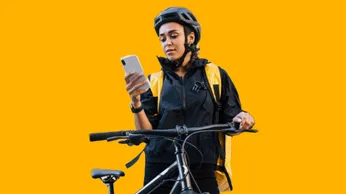On this page
Did you know that gamified workplace initiatives can increase employee engagement, driving higher productivity and a sense of belongingness? A Forbes article has revealed that 70% of business transformation initiatives fail due to a lack of employee engagement, urging employers to focus on implementing steps for employee engagement.
One of India's largest food ordering and delivery platforms uses gamification to solve the engagement of their colossal workforce of over 2 lakh delivery partners. They gamified their delivery partners' attendance, shift completion, and delivery times using Empuls, an excellent example of how gamification improves employee engagement.
Every time the delivery partners achieved the task of attending delivery for a day, delivered within timelines, and completed their shift timings, they were automatically awarded points.
These points could be accumulated to buy themselves a product or service of their aspiration - which would otherwise be difficult with just their paycheck. By the sixth month of implementation, the organization had 86% of its partners engaged and achieving targets.
Considering their operational complexity of being spread across 280+ cities, over 270 of these being tier 2 and tier 3 cities, this achievement is laudable. This reach would have been impossible if not for gamification using scalable technology. The above case is just one of the numerous applications of gamification.
Such an implementation is corroborated by research from Harvard Business School that claims that framing competition as a gain can positively impact an employee’s feeling and their willingness to find creative ways to meet their goals.
This technique is extensively used in marketing, innovation, health, crowdsourcing, learning, community building, social causes, and workplace engagement. Amongst these, this article focuses on how gamification can particularly transform workplace engagement.
What is gamification?
Gamification involves integrating game-design elements such as points, badges, and leaderboards into non-gaming contexts to motivate and increase user engagement. In the workplace, this translates to applying these elements to tasks and processes to make them more engaging and rewarding.
1. Yu-kai Chou
Yu-kai Chou, a gamification author, and international keynote speaker tells us that gamification needs to be designed around the 'core drives' of human beings. He classifies these core drives into eight categories: a higher purpose, achievement, empowerment, ownership, social influences, scarcity, unpredictability, and avoidance.
He believes that the most enchanting of gamification designs necessarily address at least one or many of the above 'core drives'.
2. Gabe Zichermann
Gabe Zicchermann, a gamification expert and public speaker, presents an interesting narrative on the biochemistry of gamification. "Any time you challenge yourselves to do a task, it doesn't matter how big or small - and you succeed - your brain secretes a magical little bit of dopamine - which makes you feel really good.
The more you do this 'challenge - achievement - pleasure' loop, the more dopamine is secreted in your brain making you want to do it more. Thus the more you succeed, the more you want to succeed."
Which elements are essential in gamification for employee engagement?
Rajat Paharia, in his book Loyalty 3.0, describes that gamification has a few or many of the following ten elements (also known as game mechanics) to it:
- Immediate feedback: The user knows whether he is winning or losing almost immediately after his actions.
- Leaderboards: The user gets to know where he is positioned from amongst the rest of the users.
- Goals: The user gets to know where they are headed and what they need to achieve.
- Badges: The user receives badges that are shorthand for past achievements.
- Leveling up: The user is taken through ascending levels of difficulty.
- Onboarding: The user is trained well - all during the course of the gameplay itself.
- Competition: The user is competing with other players or groups.
- Collaboration: The user gets to help and take help from other users.
- Community: The user gets to belong to a community of others who have similar gaming interests.
- Points: The user accumulates points throughout the gameplay.
That said, ticking off the elements of gamification does not ensure a valid gamified solution. The author of 'Gamify,' Brian Burke warns us of how a few companies have a misconception that gamification is a magic elixir that can be used to indoctrinate masses to perform the company's bidding. Users can quickly sense poorly designed solutions and start actively avoiding them, leading them to collapse.
When should organizations implement gamification?
Organizations should consider implementing gamification when they observe low employee engagement, high turnover rates, or a lack of motivation. It's particularly effective during onboarding, training, and performance management phases.
Gamified onboarding can enhance the new employee experience by making the process more interactive and informative. Similarly, incorporating gamification into training programs can improve knowledge retention and skill development.
Designing gamification for employee engagement
Brian Burke in his books and Yu-kai Chou continually emphasizes how a gamification design needs to incorporate 'core drives' or intrinsic motivations of the user. This means the game architect needs to go beyond game mechanics and study the true motivations of the target users. Along with the business scope, the user's scope in the solution needs to be constantly evaluated.
Brian Burkes derives the following seven steps that should act as a framework during gamification design - for both architects and business leaders:
1. Defining the business outcome and success metrics
All the efforts put into gamification of a solution necessarily need to link back to a business goal. Thus, the first step while deciding on a gamified business solution will be to determine the business goal that it is trying to solve.
'20% faster customer first response time' could be an ideal business outcome definition that includes a success metric of '20% improvement' for a typical customer service team.
2. Defining the target audience
Who would be the users of the gamified solution? What will be their ideal profile? What drives them? These are essential questions to understand the target audience in depth. The more this understanding, the more the gamification will address their core drives.
Referring back to the customer service team, the target audience for gamification will typically be customer service executives. Their job designs are fairly standardized, iterative, and homogeneous. Core drives like 'higher purpose' and 'achievement,' can break this monotony and introduce higher efficiencies if captured in gamification.
3. Defining player goals
The player goal has to be a subset of the business goal and should ideally coincide with at least one of the typical user's core drives.
Burke talks of an example of how a children's cancer treatment center gamified pain reporting by their patients. The kids are made a part of a "Pain Squad" where they pretend to be a police officer. They are then promoted from rookie to sergeant to chief as they regularly report their pain levels.
Drawing a quick inspiration, the customer service executives in our above example could be given a similar goal - to 'put out' or 'solve' a query as quickly as possible.
4. Determining the player engagement model
How will the users get engaged in the gamified solution? Does it make more sense to make it a collaborative or competitive play? How long is it going to last? What form of rewards will be given? These are important questions to be addressed before the design stage.
In our example, a 'competitive' engagement model makes direct sense because the executives address customer queries individually. There are ways companies have effectively made customer service gamification collaborative under the assumption of it being impossible for a customer service executive to know ALL the answers to all possible client questions. They create teams of customer executives with mixed specializations and allow them to tackle queries together.
5. Defining the play space and planning the journey
The environment the gamification is as important as the solution itself. In the context of employee solutions, it is ideal if the 'play space' is close to their CRMs and ERPs. The entire journey of the user's needs to be mapped, level by level, and challenge by challenge.
Customer Service brigadiers could be given faster-level achievements while they solve customer queries faster. There could be leaderboards showing the position of each of the brigadier's achievements and profile badges representing their positions. It is ideal if leaderboards could be reset after a final win - to democratize the opportunity to win and retry. The history of achievements should be recorded both on the profile of the user as well as a 'hall of fame'.
6. Defining the game economy
What does the user receive in return for their achievements? How can these be transacted further? How are the records of these transactions archived? The game economy is the engine for all this design to function and answering the above critical questions helps define the game design.
Since customer service is almost always a direct component of a customer service executive's KRA, better efficiencies could be incentivized using their standard performance rewarding guidelines. Points could be used to track the progress and major milestone wins can be awarded using incentive disbursals.
7. Play, test, and iterate
As with any system design, gamification also needs to open up the feedback loop and understand what needs to be changed to make the user experience seamless. Consistently upgrade the designs and try and test new game mechanics that could work towards better adoption of the solution.
Talk to the customer service executives one-on-one and understand the challenges they face in the gameplay. Get their feedback on each of the game design aspects. Reinvent parts of it if necessary- say, make it a collaborative gameplay from a competitive one?
Impact of gamification on employee engagement
While applying gamification, it is important to understand how it can impact each of employee engagement's major determinants that are listed below- since employee engagement in itself is a complex mix of occupational phenomenons.
Employees' individual characteristics are seen as the strongest predictor of employee engagement and specifically, the below characteristics are important amongst others:
1. Self-efficiency
This accounts for the individual's perception of how effective his/her skills will be for the organization and the perception of self-efficacy can be nurtured using gamification that incorporates 'pats on the back'. Employee engagement software like Empuls uses 'spot rewards' and 'badges' for this purpose and these have seen enormous results in both reward ROI and engagement.
2. Resilience
This accounts for an employee's ability to quickly adapt to the business and cultural environment of the organization and this adaptation can be made smoother and faster by gamifying the onboarding and training processes. Game mechanics of 'collaborative' ecosystems can help new employees quickly transition.
3. Personal capacities
Positive personal attributes like hope and optimism amount to how employees engage with an organization. Game mechanics like 'Onboarding' can be used to reinforce OKRs and job roles - so as to set the expectation of the role very clearly.
4. Job-design related factors
Job design is the second most important element to employee engagement and the following are a few characteristics that it consists of:
5. Feedback
Giving and receiving feedback is the most significant of all job design features and gamification can very efficiently help nurture a feedback-positive environment. Employee engagement tool and employee gamification software like Empuls use 'immediate feedback' game mechanics like 'high-fives' and '+1s' to get anonymous feedback from the other users.
Gamified surveys (filling a survey awards the user with points), feedback, polls are proven ways to increase responses and participation. Even the frequency and response time to fill feedback can be tracked and gamified.
6. Empowerment & autonomy
Gamification can provide efficient solutions to nurturing empowerment and autonomy to create engagement. Gamifying workgroup interactions and providing points to take decisions independently can be a way to implement this. Points for new ideas, issue discoveries, feedback, innovative suggestions, etc can trigger more work autonomy.
7. Opportunities for development
'Leveling up', 'Badges' and 'Leaderboard' game mechanics are efficient methods to create continuous development amongst employees. Even for leaderboards that are reset, the levels and badges will demonstrate what the employee has achieved in the past. Tying these with appraisal processes and leadership planning further boosts its potential.
8. Perceived leadership and management of the immediate supervisor
Even the supervisors can be the 'target audience' for gamification. Designing gamification that tracks the time a manager takes to resolve issues of the employee, review tasks, the frequency of team interactions, the manager's adherence to employee induction and wellbeing policies of the organization, etc. 'Competition' and 'Leaderboard' game mechanics can be used to implement these amongst managers who are in the same band.
9. Perceptions of organizational and team factors
The psycho-social climate, communication, trust, etc that exists within the organization is another determinant of employee engagement. Core values form the base to company culture and climate. Gamification can nurture these values through the use of game mechanics like 'Value-based Badges'.
Manager-level gamification can be created to track how well he/she communicates and disseminates the long and short-term organizational goals to his/her team.
10. Organizational interventions or activities
Gamification is extensively used for employee well-being activities and it has found great results in improving the fitness and overall efficiencies of the employee. Run, walk and workout miles can be tracked and 'live' leaderboards can be maintained.
People Combine, one of our clients, gamified workout milestones and reduced absenteeism related to health reasons by 50%. They used game mechanics like 'leaderboards', 'leveling up', 'badges', 'goals' and 'points'.
How Empuls, the employee gamification software could help?
Gamify employee rewards & recognition with badges, points, certificates, and leaderboards. Motivate employees and improve performance with a healthy competitive spirit using game mechanics.
Empuls empowers organizations to build a culture of appreciation and high performance by integrating gamification into everyday work experiences. Here's how it supports engagement:
1. Motivates with meaningful recognition
Empuls allows peers and managers to give timely and public recognition through points, badges, and social appreciation. This reinforces positive behaviors and aligns employees with company values.
2. Boosts performance through friendly competition
With gamified elements like leaderboards, challenges, and goals, Empuls fosters a healthy sense of competition. It encourages employees to give their best effort consistently and track their progress in real time.
3. Drives continuous engagement
The platform combines gamification with regular pulse surveys and feedback loops, helping leaders stay in tune with employee sentiment and take action to improve engagement levels.
4. Creates a reward-driven culture
Empuls connects performance and recognition with a powerful rewards engine, enabling employees to redeem points for a wide variety of digital gift cards and experiences — adding tangible value to their achievements.
5. Promotes team collaboration and participation
By gamifying collaboration, knowledge sharing, and participation in company initiatives, Empuls helps break silos and improve cross-functional engagement.
6. Enhances platform adoption
Gamified nudges and milestones encourage employees to use internal tools and communication platforms more actively, improving digital workplace adoption.
7. Personalized engagement journeys
With role-based challenges and milestone tracking, Empuls helps personalize each employee's journey based on their department, goals, and performance trends.
Schedule a call now to get a personalized demo!
Conclusion
Gamification can even solve problems once perceived unsolvable - like when a group of Foldit players solves a biochemical problem in just ten days, which remained unsolved for 15 years. This demonstrates the potential of immersive gamification. We have barely scratched the surface of how gamification can be employed to improve engagement.
With increasingly digitized work environments - there is scope to gamify almost every aspect of work. Since employee engagement spans all these aspects of work, gamification should help organizations create highly efficient and engaging work environments.















